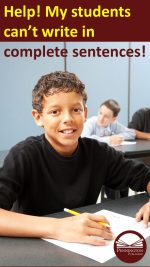How to Teach Students to Write in Complete Sentences
Developing writers often have problems writing in complete sentences. Fragmented speech, such as “Catch you later,” and text messaging, such as POS RU GO-N? help to perpetuate this problem. Additionally, students lack understanding of sentence structure, such as the roles of subjects and predicates, phrases, and clauses. I have three suggestions for teaching complete and coherent sentence writing. They work remarkably well, use only a bit of “explicit” grammatical instruction, and teach grammar in the context of oral language and writing.
The first suggestion is a problem-solving approach that does require a bit of prior grammatical knowledge. Tell students to check on “completeness” by using these three proofreading steps: 1. Identify the subject (the “doer”) and the predicate (the action or state of being). To teach subjects and predicates, check out this helpful Subjects and Predicates article:
2. Re-think whether the sentence states a complete thought. To teach recognition of sentence fragments, check out this article on Sentence Fragments. To teach recognition of run-on sentences, check out Run-on Sentences. 3. Read the sentence out loud to ensure that the voice drops down at the end of a declarative, imperative, or exclamatory (up for interrogative). This last one connects with students’ oral language abilities and is especially powerful for your grammatically-challenged kids. Of course, students can force their voices down or up and inaccurately apply this strategy, so encourage natural reading-the out loud part is crucial.
The second suggestion is a sentence revision approach that will necessitate a bit of pre-teaching. Revising with different grammatical sentence openers builds sentence variety and coherence. Students will need a reference sheet, until the models become internalized. Here’s a good one: Grammatical Sentence Openers
For example, when students write “Going to school.” as a complete sentence, students could revise with a prepositional phrase grammatical sentence opener as “To school she is going.”
The third suggestion is “tried and true” sentence combining. Of course, this necessitates teaching phrases and clauses, but my seventh graders catch on quickly with lots of modeled practice. I use lots of sentence revision activities as warm-ups to teach sentence combining. TEACHING ESSAYS BUNDLE includes 64 Sentence Revision activities to improve the quality, variety, and writing style of student sentences.
For example, when students write “After he went to work, before running errands, and picking up fast-food for dinner.” as a complete sentence, students could revise with “After he went to work, he ran errands and picked up fast-food for dinner.”
*****
The author’s TEACHING ESSAYS BUNDLE includes the three printable and digital resources students need to master the CCSS W.1 argumentative and W.2 informational/explanatory essays. Each no-prep resource allows students to work at their own paces via mastery learning. How to Teach Essays includes 42 skill-based essay strategy worksheets (fillable PDFs and 62 Google slides), beginning with simple 3-word paragraphs and proceeding step-by-step to complex multi-paragraph essays. One skill builds upon another. The Essay Skills Worksheets include 97 worksheets (printables and 97 Google slides) to help teachers differentiate writing instruction with both remedial and advanced writing skills. The Eight Writing Process Essays (printables and 170 Google slides) each feature an on-demand diagnostic essay assessment, writing prompt with connected reading, brainstorming, graphic organizer, response, revision, and editing activities. Plus, each essay includes a detailed analytical (not holistic) rubric for assessment-based learning.
Get the Writing Process Essay FREE Resource:
![]()
